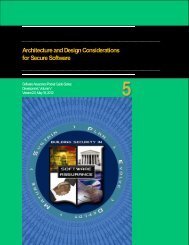Resources» <strong>Secure</strong> Software Development: A <strong>Security</strong> Programmer’s <strong>Guide</strong>. Grembi, Jason. Boston: CourseTechnology, Cengage Learning. 2008.» The <strong>Security</strong> Development Lifecycle: SDL: A Process for Developing Demonstrably More <strong>Secure</strong>Software, Michael Howard and Steve Lipner. Microsoft Press (May 31, 2006)Identify Safe and <strong>Secure</strong> Software LibrariesA variety of safe/secure libraries have been developed for various languages and purposes. Many of these libraries have beendeveloped for the C and C++ programming languages to provide replacements for standard library functions that are prone tomisuse.Types of <strong>Secure</strong> Libraries: Significant attention should be given to the sourcing of these libraries. It is often unfeasible forteams to search the libraries for tampered code; therefore, it is important that the files come from a trusted source. The definitionof a trusted source depends on the team and the software being developed. Examples of libraries to consider are:» Computer Emergency Response Team’s (<strong>CERT</strong>’s) managed string library [Burch 2010] was developed in response tothe need for a string library that can improve the quality and security of newly developed C-language programs whileeliminating obstacles to widespread adoption and possible standardization. As the name implies, the managed string libraryis based on a dynamic approach; memory is allocated and reallocated as required. This approach eliminates the possibilityof unbounded copies, null-termination errors, and truncation by ensuring that there is always adequate space available forthe resulting string (including the terminating null character).» Safe<strong>In</strong>t is a C++ template class written by David LeBlanc [LeBlanc 2004]. Safe<strong>In</strong>t tests the values of operands beforeperforming an operation to determine whether errors might occur. The class is declared as a template, so it can be usedwith any integer type. Safe<strong>In</strong>t is currently used extensively throughout Microsoft, with substantial adoption within Office andWindows. If you are compiling for only the Microsoft compiler, a very similar version is now available with Visual Studio2010. It can be used with any compiler that has good template support, and is known to work on Visual Studio 7.1 or later.» Open Web Applications <strong>Security</strong> Project’s (OWASP) Enterprise <strong>Security</strong> API (ESAPI) simplifies many security taskssuch as input validation or access controls [Melton 2009].» AntiXSS libraries are available for web applications. AntiXSS libraries focus on preventing Cross Site Scripting (XSS)attacks. These AntiXSS libraries, at a minimum, allow the HTML-encoding of all output derived from un-trusted input.Examples include the OWASP PHP AntiXSS Library and the Microsoft Anti Cross Site Scripting Library [SAFECode 2008].Securing the libraries: After picking a secure library to work with, it is important to make sure that it stays secure. <strong>In</strong> the case ofJava JAR files, it is easy to un-JAR the file, tamper with the class, and then re-JAR the file. When a problem is found, it couldtake weeks or months to determine that the problem is in the JAR file. For this reason libraries should be placed in a securedirectory, with limited access rights, to make sure they are not tampered with [Grembi 2010]. The goal is not to make the libraryimpossible to repack, but to limit who can do it.Code signing: Code signing is a technology that can be employed to ensure that libraries and functions are not tampered with orchanged. Methods for ensuring code integrity before use include Authenticode, strong naming, and Windows Side by Side(WinSxS). Code signing is also available in open-source code library tools, such as Mercurial and GIT. The key takeaway is thatthe development team needs to define and follow an appropriate code-signing strategy as part of secure coding.Centralize code libraries: Store the project’s libraries as well as the rest of the project’s code base in a control managedrepository. A code repository allows for all of the project’s code to be stored in a central place and to allow changes to bemanageable. A security advantage to this is that it makes it easy to backup the entire code base and retrieve it later if the code isSoftware Assurance <strong>Pocket</strong> <strong>Guide</strong> Series:Development Volume VI – Version 2.0, , May 18, 2012<strong>Secure</strong> <strong>Coding</strong>7
damaged [Grembi 2010]. Having the code in one place also allows the development team to assert control over who can accessthe code base.Resources» “Specifications for Managed Strings, Second Edition (CMU/SEI-2010-TR-018).” Burch, Hal, Long,Fred, Rungta, Raunak, Seacord, Robert C., & Svoboda, David. Pittsburgh, PA: SoftwareEngineering <strong>In</strong>stitute, Carnegie Mellon University,2010.» “Fundamental Practices for <strong>Secure</strong> Software Development: A <strong>Guide</strong> to the Most Effective <strong>Secure</strong>Development Practices in Use Today.” SAFECode.org. Ed. Stacy Simpson. 8 October 2008. TheSoftware Assurance Forum for Excellence in Code [SAFECode]. 13 July 2010.» “<strong>Secure</strong> Processing”. Grembi, Jason. Software Assurance Community Resources and <strong>In</strong>formationClearinghouse. 27 September 2010. 21 October 2010. .» ISO/IEC TR 24731-1. Extensions to the C Library, — Part I: Bounds-checking interfaces. Geneva,Switzerland: <strong>In</strong>ternational Organization for Standardization, April 2006.» ISO/IEC TR 24731-2. Extensions to the C Library, — Part II: Dynamic Allocation Functions. Geneva,Switzerland: <strong>In</strong>ternational Organization for Standardization, April 2010.» <strong>In</strong>teger Handling with the C++ Safe<strong>In</strong>t Class. LeBlanc, David. 2004..» “The OWASP Top Ten and ESAPI.” Melton, John. John Melton’s Weblog: Java, <strong>Security</strong> andTechnology. 3 January 2009. 4 August 2010.» “OWASP Enterprise <strong>Security</strong> API.” OWASP.org. 2 July 2010. The Open Web Application <strong>Security</strong>Project [OWASP]. 4 August 2010 .<strong>Secure</strong> <strong>Coding</strong> PrinciplesKeep Code Small and SimpleThe smaller and simpler the code base, the easier it will be to verify the security of the software. The number of flaws in the codethat implements high-consequence functions can be reduced significantly by decreasing the size of the source code modulesthat implement those functions.Ways to Shrink and Simplify Code» Ensure that the software contains only the functions that are required or specified. Adding unnecessary functions increasesthe attack surface of the software and raises the likelihood of the software being broken.» Break large and/or complex functions into smaller, simpler functions whenever possible. This will make the system easier tounderstand and document, thus making it easier to verify the security and correctness of the individual component and thesystem as a whole.Software Assurance <strong>Pocket</strong> <strong>Guide</strong> Series:Development Volume VI – Version 2.0, , May 18, 2012<strong>Secure</strong> <strong>Coding</strong>8
















